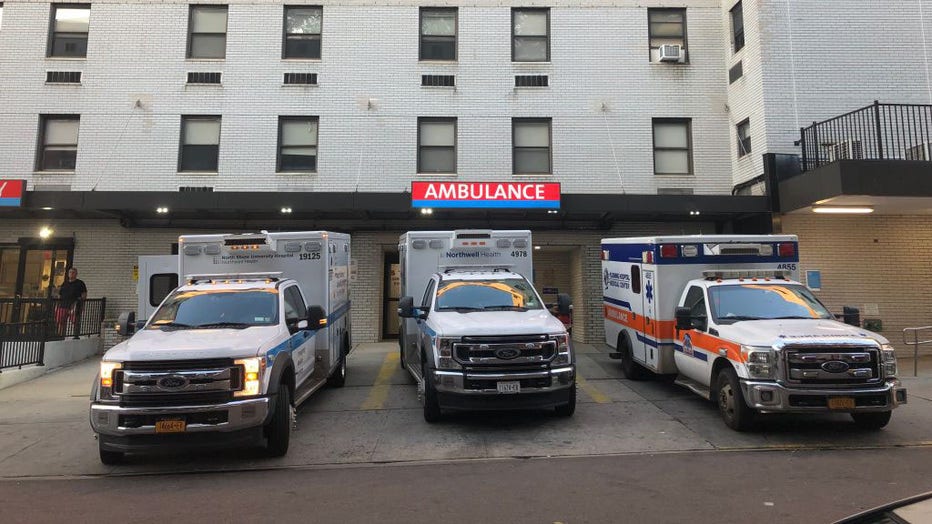Study finds spike in children going to ER with suicidal thoughts — even before pandemic

FILE - Night view of an illuminated red sign for the Emergency Department at a hospital in Walnut Creek, California on March 15, 2022. (Photo by Gado/Getty Images)
CHICAGO - If you or a loved one is feeling distressed, call the National Suicide Prevention Lifeline. The crisis center provides free and confidential emotional support 24 hours a day, 7 days a week to civilians and veterans. Call the National Suicide Prevention Lifeline at 1-800-273-8255. Or text HOME to 741-741 (Crisis Text Line).
CLICK HERE https://afsp.org/risk-factors-and-warning-signs for the warning signs and risk factors of suicide. Call 1-800-273-TALK for free and confidential emotional support.
There has been a notable increase in children and teenagers visiting emergency departments with suicidal thoughts in recent years — a concerning trend that researchers say was occurring even before the COVID-19 pandemic.
In the fall of 2019, emergency departments in Illinois experienced a spike in visits from young people between the ages of 5 and 19 with suicidal thoughts or ideas, according to a new study from Northwestern University and the Lurie Children’s Hospital of Chicago.
These types of visits additionally surged during the pandemic, which began in the spring of 2020 and triggered widespread lockdowns and social isolation. Such factors also brought a renewed focus on rising rates of depression, anxiety, and suicidal thoughts in young Americans, which the Biden administration previously called an "unprecedented mental health crisis."
Study: Pandemic may have altered personality, making young adults more neurotic, less agreeable
"A lot of people have talked about mental health problems in youth during the pandemic, but it was happening before the pandemic," corresponding study author Dr. Audrey Brewer, instructor of pediatrics at Feinberg and a pediatrician at Lurie Children’s, said in a statement.
"This has been an issue for so long, and it’s getting worse," Brewer added.
The study, published on Nov. 14 in the journal Pediatrics, analyzed the number of children who sought help from emergency departments for suicidal ideation in Illinois between January 2016 to June 2021. During this time period, there were a total of 81,051 visits by young people that were coded as suicidal ideation.
Suicidal ideation is often defined as having thoughts of wanting to hurt or harm oneself but not necessarily having made an attempt.
Overall, emergency department visits for suicidal ideation increased by 59% from 2016-2017 to 2019-2021. There was also a corresponding increase from 35% to 44% of visits in which suicidal ideation was the principal diagnosis.
Hospitalizations increased by 57% between pre-pandemic fall 2019 and fall 2020, the study found.

FILE - Three Ambulances parked outside the emergency center at Forest Hills Hospital, Queens, New York. (Photo by: Lindsey Nicholson/UCG/Universal Images Group via Getty Images)
Young people were more likely to be hospitalized if their visit included severe mental illness, substance use, anxiety, or depression, or emergency department visits to children’s or behavioral health hospitals, according to the research.
While the study focused on data in Illinois, the authors said the diverse demographics of the state’s population are representative of the general U.S. population.
Meanwhile, the researchers noted that the study examined the number of visits related to suicide ideation, and not the number of individuals. This means multiple visits could have been made by the same person.
RELATED: Seeing, listening to birds can improve mental health, study finds
‘This is like smoke,’ study author says
The U.S. Centers for Disease Control has echoed these concerns, calling suicide a "serious public health problem." Suicide rates have increased by 30% between 2000 and 2018 in the U.S., according to the agency.
In 2020, it was the second-leading cause of death for people ages 10-14 and 25-34, the CDC says.
While the study did not shed light on the causes of suicidal ideation spiking in recent years, the researchers suggested it could be a combination of factors — such as school-related stress, social isolation, including heavy social media exposure, growing hopelessness about climate change, political discord and gun violence, and family adversity, neglect or abuse.
"This is like smoke," senior author Joe Feinglass, research professor of medicine at Feinberg, said of the study findings. "And there’s definitely a fire, but we don’t yet know and are not yet addressing what is causing the fire."
The study authors stressed the need for caring, supportive interactions to improve the mental wellness of young people.
"Our health care system needs to train more community members, primary care providers and subspecialty physicians to address mental health needs for youth," Dr. Matthew Davis, chair of the department of pediatrics at Feinberg and Lurie Children’s, said in a statement. "To improve this crisis is going to require a broad, intense, coordinated approach."
RELATED: Families who eat meals together are often less stressed, survey finds
This story was reported from Cincinnati.



